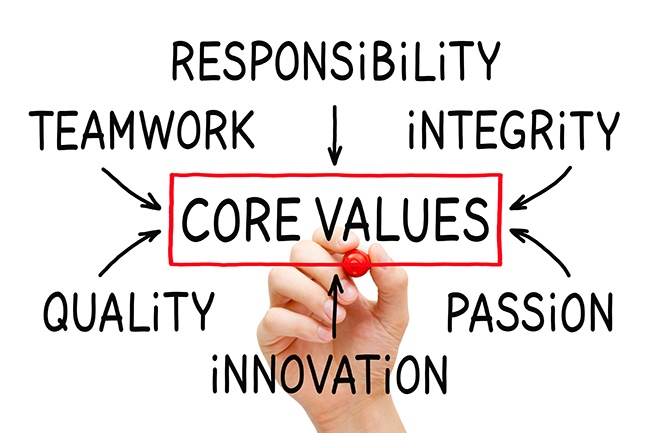Leaders, Training And Organizational Values
A statement of “Values and Code of Conduct” (or its myriad synonyms) of doing business is almost omnipresent in boardrooms, annual reports, websites, and random office walls of business organizations today, irrespective of their size and nature of business. All these statements without exception look very noble and “good.” But how well are they practiced across the organization, especially in times of ethical dilemma? How is it that some organizations end up cheating shareholders, exploiting employees, and breaking the laws of the land? How is it that CEOs and their teams end up in court and/or serve jail time or apologize on national TV?
We don’t need specific examples of large and small, well-known and little-known companies that have crumbled as a result of hubris, hunger for power, and greed of a handful of people at the top. Does this mean that organizational values are just talked about as a lip service to look “good” and because it is fashionable to have them on a wall?
I would argue that organizations misbehave (sic) because there is a wide disconnect between the beliefs and values of the organization and the beliefs and values of its leaders, who wield the power to influence the rest of the organization. Leaders need to examine their own beliefs and values and align them with those of the organization. They need to bring their empowering values into the organization while neutralizing their own delimiting beliefs. They also need to identify the same in their people and absorb what is good and block what is bad.
Individual Beliefs And Values
Individual beliefs and values dictate how our lives pan out. Are we successful, happy, healthy, in love, and wealthy? Or are we failures, miserable, sick, and lonely? Well, that depends on the network of beliefs and values we harbor in our brain.
Let’s examine what a belief is. A belief is an assertive statement we make just about everything. Life is…Success is…Love is…Justice is…Friendship means…Winning is…and so on. These declarations may be known to the person’s conscious mind or hidden deep down in their subconscious. There are literally thousands, if not millions of beliefs in each person. We all have opinions on just about everything.
When opinions combine with a certain degree of emotion, they become beliefs. When beliefs are assigned a certain worth, they become values. Unfortunately, most of our beliefs do not have validating data to back them up, either from direct personal experience or from careful observation and contemplation. They are amorphous, and often times tinged heavily with stereotypes, biases, judgments, prejudices, and cultural labels.
How do your beliefs affect your life? Your life is the sum total of your actions that arise out of your thoughts and emotions. Like lightning and thunder, thoughts come first, almost immediately followed by the concomitant emotion. But what dictates your thoughts? It is your beliefs and values that filter your thoughts.
For example, let’s say, you get cut off on the road by a rash driver. A normal emotional reaction is anger and your action is to swear loudly at the driver or grit your teeth. But before that, it is your thought that what he did was wrong. How did you know it was wrong? Well, it is your belief that tells you cutting someone on the road is plain wrong and you don’t deserve it. So, you become angry at the injustice of the whole thing because justice is a value for most people. The same cycle applies to every action you take. Your actions make your life what it is.
Organizational Values And Culture

Values like Respect for the Individual, Integrity, Performance, Passion, Diversity, Innovation, Customer Commitment, Teamwork, Quality…are commonly seen in vision and mission statements of most organizations across the world. According to a study by HBR, 55% of all Fortune 100 companies have integrity as a core value, 49% have customer satisfaction, and 40%, teamwork. Most values are shallow, bland, and politically correct without being universally owned and practiced on a daily basis. Usually, it is the leadership and HR that formulate these “values” during out-of-office retreats and come up with nice-to-have value statements.
Like individual values, organizational values are those beliefs and truisms that guide the organization (read its people) in their daily behavior and like individual values, they get into the system without much validation and rationale. Organizational values are the sum total of the values of the individuals that work in it. These real values that engender and pervade the unique culture of the company are those which each employee brings to the workplace and practices every day.
However, it is leadership that has the maximum impact on the organization’s culture and values by virtue of their positional and individual influence on the rest of the people. Leaders’ conscious and unconscious behavior, driven by their own values, shapes the values and culture of their organizations.
They also promote or obliterate values other than their own, based on how much they are in harmony with their own. Poor leadership, while fostering values, behaviors, and attitudes that are inimical to the long-term well-being and growth of the organization, shuts out the good ones that others bring to the workplace.
Aligning Individual And Organizational Values

Values guide your life’s decisions, especially when confronted with dilemmas. They tell you what is good and what is bad for you. They are the lighthouses in a stormy sea of life. Organizational values are also intended for the same purpose—to guide the company to take the right decisions and implement them for the benefit of the company. Organizational values spring from individual beliefs and values, especially of its leaders.
What are good and bad values? Ayn Rand, the Russian American writer and philosopher, defined values as something we try to acquire and/or possess. There are values that are an end in themselves and some that are the means to higher values. What is the highest value of all, a value that makes all other values possible? Well, the highest value, one that is an end in itself, is “life.” Life makes all other values possible. To the inanimate, there is no concept of value.
Therefore, life is the highest value of all. That which promotes life is “good” or “virtuous” and all that is detrimental to life is “bad” or “evil.” Life will tell us what is good and bad. Life encompasses all living creatures, not just yours. If you only take care of your life at the cost of others' lives, which includes all living creatures, you will eventually pay the cost with your own life. Life is completely interdependent. One cannot survive without the other, however small and insignificant it is. The same logic applies to organizations.
Why do we need “good” values? Because when we are born or when a company is started, we are an empty slate, tabula rasa. There is no moral compass to guide us. To survive, we need to learn how to, unlike animals or birds. They seem to know exactly what to do to live from the moment of their birth. Not so for us. Everything has to be learned. Very little is hardwired and instinctual.
Man has the power of reasoning and logic with which he continually learns and makes choices through his life—choices that are supposed to promote his life and the lives of others. Unless he knows what’s good for his life and others, how can he choose wisely? Therefore, ethics are a necessity for life; they are not a luxury.
Applying the same reasoning in an organizational context, the well-being of an organization or its “life” and longevity is a function of the well-being of the organization’s customers, employees, community, environment, and society at large. If, as a leader, your worldview is confined to say, profits and power, it is bound to negatively impact the other stakeholders in the equation. You will end up where you wouldn’t want to be.
Leaders need to think in a holistic manner, balancing all the essential constituents that promote the life of the organization. It is not the sole responsibility of leaders but of everyone concerned, customers, employees, and the government that need to keep a check on the leadership. In more ways than one, we are our brother’s keepers as we sail or sink together. Therefore, it is imperative that our individual beliefs and values are aligned with our organization’s code of conduct.
To align and promote “good” values, leaders need to first identify their own beliefs and values. For most people, beliefs seep into their subconscious unchallenged. They permeate their minds at unguarded moments from various sources. One of the main sources of these unfiltered beliefs is figures of authority—parents, teachers, older siblings, leaders, religious heads, bosses, and the like. The others are experience and observation. Rarely does a person deliberately chose their beliefs after careful contemplation. Beliefs are, of course, of two types: limiting and empowering. Ideally, we should keep and accumulate the latter and identify and jettison the former.
Any problem that keeps recurring, either in an individual’s life or in an organization, points to an underlying limiting value; it is just a manifestation of that value. Problems are the most direct way of identifying limiting beliefs and values. If you remove them, the problems disappear. Likewise, the areas that are working out well are because of the underlying empowering beliefs and values. Most empowering values are good for the individual, the organization and community, and the world in general. That explains why most of the values touted by organizations look very similar. But the question is: Do leaders practice the same values in their own lives? If the organizational value is “integrity,” how important is integrity for its leaders? Are they willing to accept a short-term financial loss to uphold this value for long-term growth?
It is a painful process to change beliefs and values. If you are not willing to endure that pain, you can never be a successful leader. This change should be “inside-out.” As Mahatma Gandhi exhorted, “You must be the change you want to see in the world.” When asked if he would die for his beliefs, British philosopher and Nobel Laureate Bertrand Russel reportedly said, “Of course not, I may be wrong!” But most of us do not have such strength of character. We actually die and kill for our beliefs. Open any newspaper anywhere in the world and you will read many such stories every day about individuals and companies.
One reason why we find it very difficult to change, even to just confront our beliefs, is probably because we identify ourselves too closely with them. Our self-image, self-worth, and our very existence are intertwined with our beliefs. We are mortally afraid that our very existence will be in jeopardy if our beliefs are proven to be false. So, we’d rather be wrong and miserable than right and liberated. But then, as George Bernard Shaw, the Irish playwright and Nobel prize winner in literature said, “Those who cannot change their minds cannot change anything.” This especially applies to leaders.
Training On Values
As training and L&D professionals, we know that attitudinal training is infinitely more difficult than training on knowledge and skills. We also know that attitudes and behaviors are deep-rooted and very difficult to change as discussed in the preceding paragraphs. When we know good values are a necessity, and that as leaders we are the custodians of our organizational values, it becomes imperative we inculcate them in our people. Among other initiatives like policies and systems that encourage good practices, can we not train our people on good values?

When organizations are training on leadership, teamwork, and diversity, why not on values? Of course, no training can make any difference unless the leaders “walk their talk.” Assuming the leadership is doing just that, a blended learning strategy that includes personal growth labs, workshops, eLearning, and microlearning, carefully designed and implemented can produce the desired results. If we can demonstrate “what’s in it for me?” and lead by example, I think it can be done.


